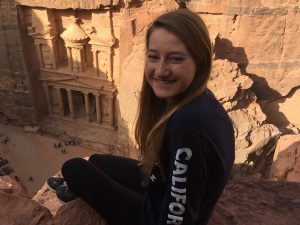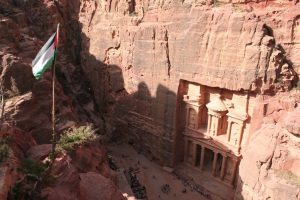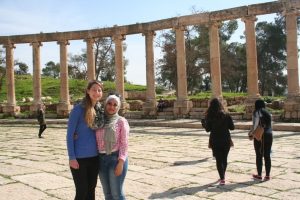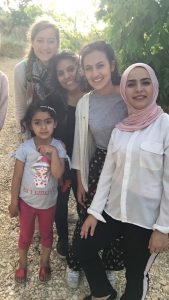MarHaba! My name is Theresa Smiley, and I’m incredibly excited to share a bit of my experience with Arabic outside of the Loyola community. I just finished my junior year, and I’m currently majoring in Global and International Studies and Political Science, with minors in Arabic Language and Culture, Islamic World Studies, and German Studies. Additionally, I recently returned from a semester studying abroad in Amman, Jordan, where I participated in an intensive Arabic language program through CET Academic Programs. It was a whirlwind of a semester, but in between all the studying and traveling I made some amazing friends and learned so much Arabic. Ustaadha Sawsan’s Arabic 101 and 102 classes gave me a strong foundation in both fusHa (Modern Standard Arabic) and a’mia (the Jordanian dialect), and then CET built on those foundations to give me the skills I needed to navigate Amman.
During my time in Jordan, I visited Petra, the Dead Sea, Wadi Rum, Mount Nebo, and countless historical and cultural sites in Amman. The craziest thing, though, is that throughout all of these adventures I was speaking Arabic. My program required a language pledge, so all the students were supposed to speak Arabic 24/7. While everyone broke the language pledge at least once during the semester, during our classes and the various trips around Jordan everyone was speaking Arabic all the time. Because of this, we learned a lot of unique vocabulary. By the end of the semester, I could speak about the various Roman ruins we had visited and read the Arabic signs explaining the history of the cities. Because some of the signs were not listed in English, this vocabulary was necessary for learning about the incredible history of Petra and the Roman ruins in northern Jordan. Without my Arabic, all of that history would have been lost on me.
Additionally, CET included a language partner program, so for three hours each week I would sit down and chat with a student attending the University of Jordan. My language partner’s name was Nagham, which means “note” or “melody” in Arabic, and we quickly became good friends. We would chat in Arabic about our favorite singers and food, and as my Arabic improved we began to delve into more complicated topics. Towards the end of the semester she explained the Jordanian system of government to me, and we talked about the differences in high school and college education in Jordan and America. Below is a photo of Nagham and I during CET’s trip to the Roman ruins in Jerash, a city in northern Jordan.
Finally, one additional unique aspect of my program was the living situation. All the students lived in apartments off-campus with one or two other American roommates and a Jordanian roommate. This gave us an opportunity to get to know a few Jordanian students and form really strong friendships. My Jordanian roommate’s name was Sajeda, and we got along really well. She taught us how to cook a few traditional Jordanian recipes, and we had lengthy conversations in Arabic about the differences between life in American and life in Jordan. The last weekend of the program she even took my other two American roommates and I to visit her home in Jerash. There, we had the opportunity to meet her family, and her mom even cooked us mensaf, the national dish of Jordan. Below is a photo of my two American roommates, Sajeda, Sajeda’s little sister, and I outside of her home.
Overall, I had an amazing experience in Jordan, and learned so much about the country’s culture and history. I also learned, however, how important Arabic is when you are traveling in the Middle East. A lot of people in Jordan did not speak English, and Arabic was necessary for communication. Without my knowledge of Arabic, I would not have been able to fully immerse myself in this amazing country.




